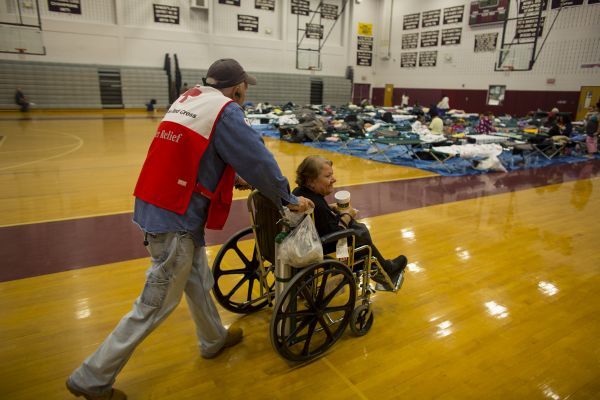As Hurricane Irene made its way up the East Coast at the end of August 2011, 26-year-old Tania Morales did everything she was supposed to do. She tuned in to the news, made arrangements to get around without the Metropolitan Transportation Authority, and when Mayor Bloomberg ordered a mandatory evacuation of people residing in Zone A of the city’s Area Evacuation Plan, she headed to a nearby shelter at a public school that she’d found on the city’s website.
When she arrived there in her motorized wheelchair, the trouble started. The ramps that she remembered leading up to the front door were blocked by locked gates. As the volunteers staffing the shelter searched for the keys, the wind started picking up. Ten minutes later, scared for her safety and worried about the approaching weather, she returned home to wait out the storm. “With no place to go and no emergency information about what I should do, I was terrified,” she said.
One month later, Morales and two non-profit groups that advocate for the disabled filed a class-action lawsuit against the City of New York, claiming it “failed to plan appropriately for the nearly 900,000 disabled persons within New York City who are especially vulnerable during disasters.” This month, a year after Hurricane Sandy and two years after they initiated legal proceedings, Jesse M. Furman of Federal District Court in Manhattan decided in their favor.
“The mountain of evidence and argument confirms that planning for, and responding to, emergencies and disasters is a herculean task, and that, in many—perhaps most—respects, the city has done an outstanding job,” Judge Furman wrote in his 119-page ruling. “But it also reveals that while the city’s emergency preparedness program adequately accommodates the needs of people with disabilities in some respects, it fails to do so in others. Most significantly, the city’s plans are inadequate to ensure that people with disabilities are able to evacuate before or during an emergency; they fail to provide sufficiently accessible shelters; and they do not sufficiently inform people with disabilities of the availability and location of accessible emergency services.”
What exactly this ruling means for New York, the United States and cities around the world is still unclear, as the trial was limited to liability. Now that the city’s legal obligation has been established, both sides will have the opportunity to propose and negotiate remedies. If they fail to do so, or fail to agree, the court will take action and mandate changes that bring the city’s evacuation planning in line with the Americans with Disabilities Act.
In response to the ruling, NYC Corporation Counsel Michael A. Cardozo said in a statement, “Planning for the needs of people with disabilities has always been and remains a priority for the city. We are continuing to review this decision and assess our next steps.”
Those next steps could have ramifications for cities nationwide, says Julia Pinover, the senior staff attorney for Disability Rights Advocates who argued the case. “Whatever plan NYC comes up with will become a model for the rest of the nation,” she says. “Because this ruling is federal law, it sends a message that not only is preparing for everyone’s needs morally right, but it’s also legally mandated.”
The issues raised in the lawsuit are familiar to advocates for disabled persons, as well as those in the emergency planning community. In the wakes of Hurricanes Katrina and Rita, the National Council on Disability published a report finding that, “People with disabilities were disproportionately affected by the Hurricanes because their needs were often overlooked or completely disregarded. Their evacuation, shelter and recovery experiences differed vastly from the experiences of people without disabilities.”
A close reading of Judge Furman’s ruling points to a few procedural issues that will likely be addressed as a result of this case. The first has to do with the meaningful participation of the disabled community in disaster planning. During the trial, the city described its efforts as “collaborative and inclusive,” while an expert witness for the plaintiffs said, “The disability community has not been meaningfully and effectively engaged.” It’s very likely that in the coming months and years, disabled New Yorkers will play a more significant role in evaluating and shaping the city’s evacuation policies.
Certainly — whether through court order or conference — the six areas in which the court found the city in violation of the Americans with Disabilities Act will also be addressed. That means there will be revisions to evacuation plans with regard to high-rises and accessible transport, shelter accessibility, canvassing before and after an emergency, resource distribution in the aftermath, outreach and education, and strategies to spread information about the existence and location of accessible services.
Judge Furman ordered that the parties submit a joint letter updating him on these issues by the end of November. He also set a conference date for the start of December.
Looking further afield, Michael J. Prince, the Lansdowne Professor of Social Policy at the University of Victoria and an expert in disability policy, says inclusive disaster planning will need to become the norm in an era of stronger storms. “With climate change and more hurricane and freak weather systems, these emergencies seem to be happening more frequently, and so municipal authorities need to look at their plans through a disability lens,” he says. “The government needs to be there for all of its vulnerable populations. This case establishes that that’s a reasonable expectation for even the biggest cities.”
Right now, however, Pinover from Disability Rights Advocates is more interested in the short term. “We want to put remedies in place fast,” she says. “In an ideal world, we wouldn’t be litigating this. The Bloomberg administration was not willing to work with us. The de Blasio administration might be.”

Graham T. Beck has written about art, cities and the environment for the New York Times, The Believer, frieze and other august publications. He’s a contributing writer for The Morning News and editor-in-chief of Transportation Alternatives’ quarterly magazine, Reclaim. He lives in New York City and tweets @g_t_b

















